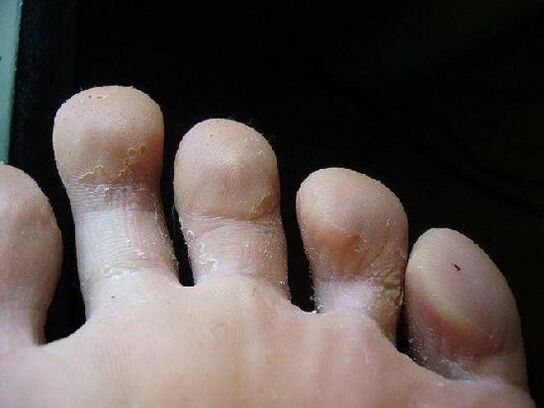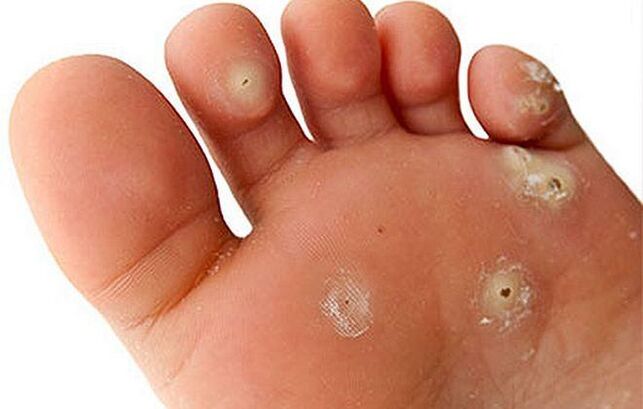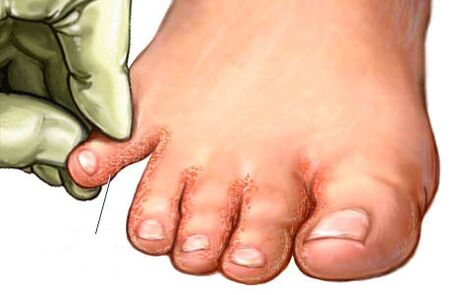Foot fungus is a seasonal disease and mainly manifests itself in the season of wearing closed shoes. Fungal infections of the feet do not attract as much attention as other types of fungi, such as toenail fungus. This is because the foot is not visible unless you look at it specifically. And the first, not strong manifestations, are attributed to everyday motives.
The easiest way to test for foot fungus is to smell your shoes! A bad smell is a sign of fungal infection. Although the fungi themselves do not give off a smell, but their residues. . . In addition, the residues of microorganisms that have settled on wounds formed by a fungal disease. And, most of all, these are staphylococci. All of this together is what causes unpleasant odors in shoes and feet.
Combing the skin of the affected area leads to the spread of the infection!
When your feet are in hot, closed shoes for a long time, they sweat profusely. The fungus, which under normal conditions is not activated, once in an ideal environment for itself, begins to actively develop. Hence the second name of this disease - "Athlete's Foot". Fungal disease of the feet, caused by various types of fungi. And because athletes spend most of their time in tight, closed shoes, they mostly suffer from this ringworm.
Athlete's foot is quite common. With it, a fungal infection of the sole of the foot or areas of the skin occurs between the toes.
These mycoses can be caused by the appearance on the foot of one of the varieties of a parasitic colony of an infectious and highly contagious disease called fungus on the feet.
The fungal diseases that cause extensive skin lesions are caused by several types of fungi, whose nature is evidenced in the study of the analyzes.

How the fungus manifests
In the skin of the legs, the pathology initially manifests itself in small areas with a tendency to flaking, then the stain spreads with irregular edges and the ringworm becomes more pronounced.
The activity of manifesting symptoms of fungi in the legs can be fast and quite slow. Because it all depends on how strong a person's immunity is and the type of microorganism that brought about this disease.
The types of fungi on the feet are quite different and manifest in their own way, but if a person has any pathological changes in the feet, they should consult the experts for the reason. Mycologists will explain what a fungus is and teach you how to fight it.
What does the foot fungus look like?
The fungus of the feet is accompanied, in most cases, by the "athlete's foot" - it looks like an almost imperceptible scaly skin. As the pathology spreads, the color of the skin changes to red and the changes become more noticeable. In addition, foot disease looks like large areas with large flakes of dry skin, sometimes the signs are located on one side, sometimes on both sides of the foot. The location of the foot fungus is usually located at the bottom of the limbs, and the appearance of the limb depends on the degree of development of the pathology.
Differences in species are considered, such as:
- a very dense stratum corneum on the sole;
- flakes begin to peel the honey with your fingers;
- the skin is inflamed;
- the foot injury also looks like blisters.
The fungus formed on the legs seems quite expressive, so the person must notice specific manifestations and consult a doctor.

Causes of foot fungus
What to do if a fungus appears? To begin with, it is worth finding out the reasons for its appearance and thinking about where exactly the spores can be caught and why the body has not responded adequately.
About how athlete's foot formation begins, about the reasons that precede the development of pathogenic flora, mycologists say the following: a fungus on the feet of the feet can develop if the person wears socks or shoes from an infected person and also does not useslippers in places where large numbers of people pass, namely, in public baths, saunas and swimming pools, as this is where the most favorable soil for the bacterial front is found.
How to identify fungi on the feet
The development of mycoses, a fungal disease that causes at a very high rate, and especially rapidly, such manifestations develop if there are concomitant chronic illnesses. Diseases of the feet can be determined independently, but in order not to confuse all skin abrasion with signs of fungus on the legs, it is worth carefully considering the condition of the skin, as well as the appearance of the skin under the toes.
The fungus on the legs is quite diverse in its symptoms, as the types of fungus on the legs are also not limited to one, and each of them has its characteristic manifestation.

What does a fungus look like on the foot
And the appearance of the fungus on the skin of the legs will determine which species it is. So to speak, the mycelium will leave its "business card" upon arrival.
Sometimes people with a history of this pathology don't even know it, they just see a very dry cover on their legs, but they mean it should be like that.
The general symptoms are usually like this:
- the appearance of micro-cracks;
- mild itching, especially between the toes;
- severe peeling;
- sometimes swelling and pain in places where erosion occurs;
- rarely, but bleeding occurs.
- deep cracks may appear.
How to cure fungus on the feet
The treatment of the fungus on the feet is a long process, but if the preparatory step is carried out correctly, that is, when diagnosing which parasitic pathogen in the body, the therapy can be faster.
It is necessary to treat skin fungi comprehensively, using both medicines for internal use and external medical pharmacological agents.
Athlete's foot can be treated with careful study of all affected areas; this should be facilitated by a course of treatment.
On how to treat the fungus, you need to consult the mycologists. They will be able to talk in detail about which medications are capable of coping well with the disease.
The treatment of foot disease can be divided into several parts. An important and primordial task is to strengthen the most vulnerable areas and to rehabilitate areas affected by the disease. It is important to know that your feet should always be dry and clean:
- and also shoes must be made of materials that breathe;
- replaceable cotton socks should become a good absorbent that collects moisture;
- after the feet have been shoved all day, it is necessary to rinse them well and lubricate them with a special agent prescribed by a doctor.
It is also good to use special powders that help keep your feet dry.
The next part of treatment involves the use of antifungal drugs, such as:
- ointments with a special composition;
- a cream with a lighter texture than an ointment, which means a greater angle of penetration into the interior;
- aerosols, the smallest particles of which penetrate the most difficult places to access.
And although almost all pharmacological preparations for the removal of pathogens are marketed in the pharmaceutical retail chain without a special prescription, consultation with an experienced specialist will not only not be superfluous, but, on the contrary, will help to have a complex effect on this disease.
The most common reasons for which the treatment has no effect are, in the first place, the disruption of the treatment regime and the irregular use of funds.
There are also the following reasons:
- many patients do not understand the severity of the disease and do not accept the proposed treatment;
- about a third of the sick do not go to the specialist and occasionally self-medicate, which, for obvious reasons, does not bring relief;
- many patients do not believe that it is necessary to accurately diagnose a type of pathogen;
- many, as soon as the first positive results are achieved, stop the treatment on their own.
How foot fungus is treated with folk remedies
You can also treat foot fungus with home remedies.
There is a good tool, you can do it yourself.
Ointment that well destroys ringworm of the feet:
- vinegar essence - 110 grams;
- a raw egg;
- butter - 200 grams (it is better to take it from the natural farmer).
Scrub with absorbents from the kitchen shelf:
- refrigerator;
- drunk coffee;
- rolled oats;
- rice flour.
These components, introduced in the foam, can be excellent assistants when sanding the skin of the feet. They are great for exfoliating skin particles and releasing areas that need to be treated with unnecessary layers.
Compress with anesthetic solution.
A gauze pad is soaked in anesthetic solution and reinforced in the leg at night. In the morning, the dressing is removed and the affected areas are treated with a decoction of chamomile. Repeat for 7 days.
If you study the subject well, then foot disease can be treated with folk remedies, and the fungi on the skin of the legs will pass without a trace, with no possibility of recurrence.

Consequences of advanced ringworm on the skin of the legs
The treatment of fungi on the skin of the legs must be comprehensive and timely, otherwise the following complications may occur:
- the parasitic elements themselves, as well as the products that remain after their vital activity, increase the risk of allergies in patients;
- the course of dermatitis can be complicated by the occurrence of eczema and psoriasis;
- as the skin is severely injured, the infection penetrates the lower layers of the epidermis without hindrance and causes the onset of lymphasis.
With athlete's foot, warts appear much more frequently and hyperkeratosis can occur.
Preventive measures
Foot fungus, or rather, its occurrence, can be prevented.
First, it is possible to use ointments and folk remedies as additional protection, and then the treatment of the fungus, even if it occurs, will be done according to a simplified scheme.
It is also necessary to perform the following steps:
- eat as prescribed for a healthy lifestyle;
- observe hygiene procedures;
- strengthen the body's immune defenses;
- apply preventive precautions.





























